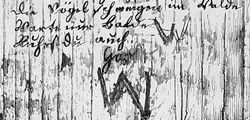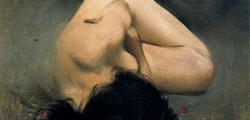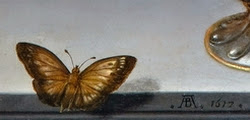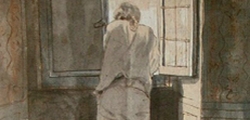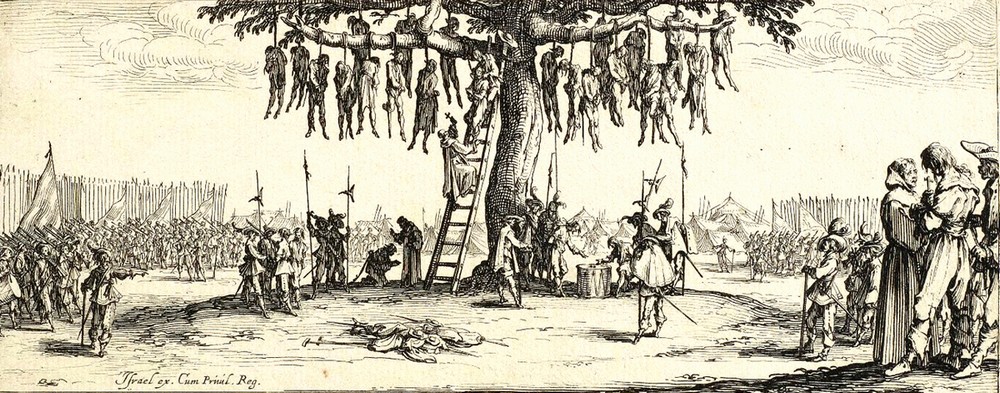
The Thirty Years' War was one of the most terrible episodes in the History of Europe. Officially, it was a war of religions, which began in 1618 with the so-called "defenestration of Prague" and ended in 1648 with the Peace of Westphalia. Of course, the real reason wasn't the disputes between Catholics and Protestants but a political struggle (in fact, there were odd alliances between Catholic and Protestant kings, nothing unites as much as a common enemy); besides, the fact that three ambassadors of the Holy Roman Emperor were thrown out of a window of a castle in Prague was just an anecdote (except for the ambassadors, who miraculously survived a more than twenty meters fall). The treat of peace was just a date marked on books, a war like that doesn't end all of a sudden.
However, those thirty years were very real; they seemed to go on forever, so many people were born and died without knowing anything else. What happened on the battlefield, despite being ferocious and causing a terrible number of casualties, was the least of the problems for the population. The armies of mercenaries had to be fed and paid, so, barbarized and degraded, they simply became self-sufficient: they burgled, raped and vandalized everything in their path. Troops moving and people fleeing spread the epidemics of plague, typhus or scurvy; Famines became chronic because the fields couldn't be harvested. Estimates of victim figures are terrible: some sources speak of eight million people; others reckon between four and twelve million. In most affected territories, which would match approximately with present-day Germany, a quarter of the population died, but there were areas where this figure were the survivors.
Novels such as Simplicius Simplicissimus, written twenty years after the end of the war, or collections of tales and poems such as those of the Brothers Grimm or Arnim and Brentano, published in the early nineteenth century, show the brutality of that time. The apparent chaotic blend of humor, tragedy, joy and sarcasm of the twenty-four lieder that Mahler wrote from Des Knaben Wunderhorn give us a clue of how horrific and ridiculous everyday life was.
That's where I was going, Mahler, of course, his stories of soldiers and one of my favourite lieder, Wo die schönen Trompeten blasen (Where the beautiful trumpets blow). It's easy to imagine the context of an endless war, the fear when someone knocks at the door at night, the anguish of farewell, the presence of death everywhere. Mahler took the text for this Lied from two poems from Des Knaben Wunderhorn which tell a similar story: a boy visits his beloved, at night, before going to war; Both poems have a similar structure, with a narrator and a dialogue between a couple, and even an almost identical verse. Unbeschreibliche Freude (Indescribable joy) has only four verses; The title of this article refers to the last one, where the young man says that he wishes the fields were paper so as the poets would sing their love. Bildchen, which we can translate as "Little portrait" (the girl’s portrait the boy will take with him) has nine verses and ends in a very similar way to Mahler's song.
The composer musicalized a five stanzas poem, he rewrote the two original poems and added something that doesn't appear in any of them: a nightingale singing in the distance. The text of the song reveals the possibility (for some people) or clearly tells (for others) that the soldier is dead and the young woman welcomes a ghost who announces her death within a year. Music, Mahler’s wonderful music, adds some ambiguity (for some people) or underlines (for others) the supernatural nature of that night visit.
Throughout the Lied, the weight of the orchestration is distributed between winds and strings. Maybe "weight" is not the best word, because the colours and textures chosen by the composer make the winds sound distant and almost as in dreams (in fact, the initial indication is verträumt und leise, "dreamily and quietly") and the strings, light, ethereal. The first thing we hear is the rumour of the war, far away, and caution when someone knocks; that's told by woodwinds and metalwinds. When the young man asks her to let him in, the music transforms into a sweet dance played by strings. With the narrator, who explains how the girl gets out of bed and opens, the winds, the war, return; the welcome words are led by the strings, until the nightingale sings: then, the trumpets sound and the girl weeps.
She may weep because there are together again, because of the certainty of their farewell or because, traditionally, a nightingale singing announces somebody’s death. During the rest of the song, only the young man speaks, accompanied by the strings when he consoles his fiancée, and then by the winds, when he talks about the war and his house made of green grass. In spite of this reference to the tomb and the nightingale detail, which he himself had added, Natalie Bauer-Lechner, whom we’ve mentioned in other occasions, explains that Mahler and his friend Siegfried Lipiner discussed how the song should be understood: while Lipiner argued that the visitor was a ghost, the composer argued that the boy was alive.
In short and as always, performers and listeners are left to decide for ourselves. We're listening to Simon Keenlyside and the Birmingham City Symphony Orchestra, conducted by Simon Rattle. Enjoy the gorgeous song and, if you feel like, think about it: is it a farewell, and the boy is trying to make her feel better by telling he will be back in a year? Is it a hallucination of the young woman, who receives the visit of a doppelgänger at the very same moment that the young man dies? Does she know that he is dead and dreams of her own death? Does the young man come back from death to declare once more his love and that they will meet again soon?
Wer ist denn draußen und wer klopfet an,
Der mich so leise wecken kann?
Das ist der Herzallerlieble dein,
Steh auf und laß mich zu dir ein.
Was soll ich hier nun länger stehn?
Ich seh die Morgenröt aufgehn,
Die Morgenröt, zwei helle Stern.
Bei meinem Schatz, da wär ich gern,
Bei meinem Herzallerlieble.
Das Mädchen stand auf, und ließ ihn ein,
Sie heißt ihn auch willkommen sein.
Willkommen, trauter Knabe mein,
So lang hast du gestanden.
Sie reicht ihm auch die schneeweiße Hand.
Von Ferne sang die Nachtigall,
Da fängt sie auch zu weinen an.
Ach weine nicht, du Liebste mein,
Aufs Jahr sollst du mein eigen sein;
Mein eigen sollst du werden gewiß,
Wies keine sonst auf Erden ist.
O Lieb auf grüner Erden.
Ich zieh’ in Krieg auf grüner Haid’,
Die grüne Haide, die ist so weit.
Allwo dort die schönen Trompeten blasen,
Da ist mein Haus von grünem Rasen.
Who is then outside, and who is knocking,
Who can so softly, softly waken me?
It is your darling,
Arise and let me come in to you!
Why should I stand here any longer?
I see the dawn arrive,
The dawn, two bright stars,
With my darling would I gladly be,
With my heart's most beloved!
The maiden arose and let him in;
She welcomed him as well:
Welcome, my beloved boy,
You have stood outside so long!
She reached to him her snow-white hand.
From afar a nightingale sang;
The maiden began to weep.
Oh, do not cry, my darling,
Next year you shall be my own!
My own shall you certainly be,
As no one else on earth is.
O Love on the green earth!
I go to war on the green heath,
The green heath that is so broad!
It is there where the beautiful trumpets blow,
There is my house of green grass!
(translation by Emily Ezust)


